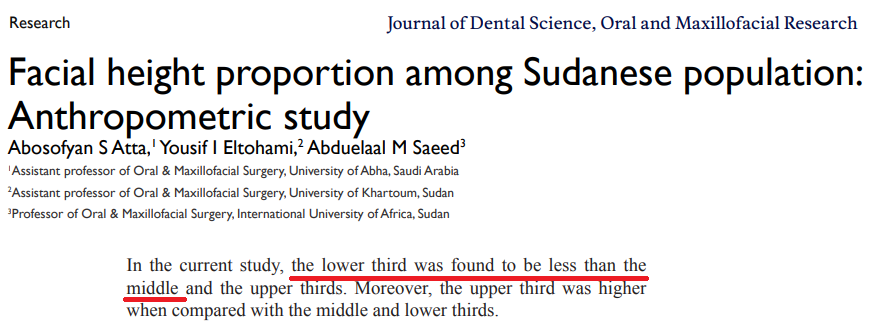Summary
The face height middle-third to lower-third ratio is crucial in facial aesthetics and attractiveness, comparing the middle third (eyebrows to nose base) to the lower third (nose base to chin) of the face. Lakhiani & Somenek (2019) noted that females typically have a smaller mandibular width and angle flare, a rounder and smaller chin, and more vermilion show, resulting in a larger middle-third to lower-third face-height ratio, enhancing perceived femininity. Atta et al. (2019) conducted a study with 720 Sudanese participants (365 females, 355 males) aged 18 to 60, measuring the face’s upper, middle, and lower thirds. They found the lower third was smaller than the middle third, indicating a higher middle-third to lower-third ratio. Moreover, Rathi and Chhetri observed that the middle facial height was slightly higher in females, while the lower facial height was significantly greater in males. This suggests that females have a proportionally larger middle third and a smaller lower third, leading to a higher middle-third to lower-third face height ratio in females.
Research
The face height middle-third to lower-third ratio is a significant factor in facial aesthetics, particularly in the context of attractiveness. This ratio compares the height of the middle third of the face (from the eyebrows to the base of the nose) to the height of the lower third (from the base of the nose to the bottom of the chin).

According to Lakhiani & Somenek (2019), females have a smaller mandibular width with lesser mandibular angle flare, indicating a less pronounced face height lower-third. Moreover, females have a rounder and smaller chin, which results in a lower face height lower-third. Additionally, females have more vermilion show (the visible part of the lips), which means a more pronounced middle third compared to males. All these factors result in a larger middle-third to lower-third face-height ratio, contributing to the perceived femininity of the face.

Another recent study by Atta et al. (2019) that intended to determine the facial height proportion among Sudanese population. The current study included 720 participants (365 females (50.7%) and 355 males (49.3%)). The age range is between 18 to 60 years. The study used a digital caliber to measure the upper facial third (trichon−glabella), middle facial third (glabella−subnasale), and lower facial third (subnasale−gnathion). In the study, the lower third was found to be less than the middle third, thereby, implying that the middle-third to lower-third ratio is higher.

Moreover, according to a research article by Rathi and Chhetri, the middle facial height was slightly higher in females than in males. This suggests that the middle third of the face is proportionally larger in females. On the other hand, the lower facial height was significantly greater in males than in females. This indicates that the lower third of the face is proportionally smaller in females compared to males. Therefore, the ratio of the middle-third to lower-third face height is higher in females.

References
Lakhiani, C., & Somenek, M. T. (2019). Gender-related facial analysis. Facial Plastic Surgery Clinics, 27(2), 171-177. https://sci-hub.wf/10.1016/j.fsc.2019.01.006
Atta, A. S., Eltohami, Y. I., & Saeed, A. M. (2019). Facial height proportion among Sudanese population: Anthropometric study. J Dent Maxillofacial Res, 2(4), 95-99.
Rathi, A., & Chhetri, S. Measurements of Lower, Middle and Upper Facial Heights in Different Sex in a Teaching Hospital of Biratnagar.
